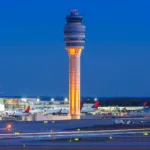Airport lightings are critical for the safe movement of aircrafts during night operations and low visibility conditions. Every airport shall be equipped with standard lighting system as per ICAO.
Airports are equipped with several lighting systems for low visibility operations and night operations. These are standardized as per ICAO and will be same throughout the world. These lights vary depending on the type of airport classification, approach capabilities etc., Also the properties of these lights are diverse. The tower controller controls the intensity of these lights as per the pilots request or the visibility conditions.
Here is the list of most common airport lightings.
Aerodrome beacon
This is rotating beacon mounted on a tall structure usually on the top of a terminal building or the control tower to help identify the pilot about the airport.
These are usually white and green or yellow lights rotating at a fixed rate and best visible 1-10 degrees above the horizon. These are constantly rotating and produce the flashing effect. The type of light combination used helps identify the type of airport.
approach lights
Based on the category of aerodrome approach, approach lights configuration will vary. The complexity increases as the precision of approach type increases. These are the light a pilot will first identify when preparing for landing. These lights are extended up-to 900m and are usually white. Approach lights main purpose is to help pilot align the aircraft for landing (horizontal guidance).
Vertical guidance lights (PAPI)
PAPI or Precision Approach Path Indicator lights give vertical guidance to the aircraft. These are a set of 4 lights of Red and white.
| Lights Pattern | Vertical Guidance |
| Red, Red, Red, Red | Too low on approach |
| Red, Red, Red, White | Slightly low on approach |
| Red, Red, White, White | On Glide path |
| Red, White, White, White | Slightly high on approach |
| White, White, White, White | Very high on approach |
runway lightings
- Runway Edge lights: These are white lights at a fixed interval ( 30m or 60m ) and these lights become yellow as we approach the end of the runway and are red lights at the end of the runway. The specifications for when the color changes is specified in the ICAO website.
- Runway Centerline lights: The runway centerline lights are in white color are vital for a pilot to align the aircraft accurately on the runway.
- Runway Threshold Identification Lights: RTIL are uni-directional white flashing lights and are placed only at the beginning of the runway.
- Runway Touchdown Zone Lightings: Runway Touch down zone lights are critical in a precision approach runway. They help the pilot identify the touchdown zone. These are symmetrically placed white lights along the center line of the runway. Usually set of three lights on each side of the center line.
- Runway End Lights: Runway End lights are in red color to indicate the end of the runway
Taxiway lightings
- Taxiway Center Line Lights: These are equally spaced green color lights to indicate the centerline of the taxiway.
- Taxiway Edge lights: Taxiway edge lights mark the boundaries of the taxiway on both the sides are blue in color.






